![]()
![]()
![]()
Use LEFT and RIGHT arrow keys to navigate between flashcards;
Use UP and DOWN arrow keys to flip the card;
H to show hint;
A reads text to speech;
20 Cards in this Set
- Front
- Back

|
Sumerian *Statues of worshipers from Abu Temple, Tell Asmar Limestone, alabaster, and gypsum, Iraq. ca. 2700-2500 BCE They hold small beakers the Sumerians used in religious rites. The men wear belts and fringed skirts. Most have beards and shoulder length hair. The women wear long robes, with the right shoulder bare. Most striking is the disproportionate relationship between the inlaid oversized eyes and the tiny hands. Because the purpose of these votive figures was to offer constant prayers to the gods on their donors' behalf, the open-eyed stares most likely symbolize the eternal wakefulness necessary to fulfill their duty. The difference in size represents the level of importance in their society. |
|
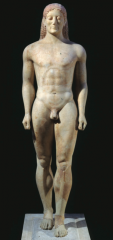
|
Archaic *Kroisos, from Anavysos, Greece, ca. 530 BCE. Marble, 6' 4"high. -A young man named Kroisos died a hero's death in battle, and his family marked his grave at Anavysos, not far from Athens, with a Kouros statue. Although the stance is the same as in the earlier Kouros, the sculptor's rendition of human anatomy is more naturalistic. The head is no longer too large for the body, and the face is more rounded with swelled cheeks, The long hair does not form a stiff backdrop but falls naturally. Rounded hips replace V shaped ridges of the earlier statue. Also new is that Kroisos smiles-or seems to. From this time on, Archaic Greek statues always smile-even in inappropriate contexts. This "Archaic Smile" is the archaic sculptors way of indicating that the person portrayed is alive. |
|
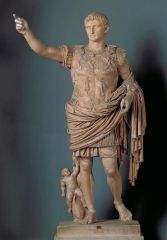
|
Early Classical or Transitional Period *Augustus of Primaporta, Italy. Early 1st century CE. Height 6’ 8”, marble,. -This is the first Roman emperor, Augustus, which means, “Supreme Ruler.” He was the grandnephew and adopted son of Julius Caesar. When Augustus became emperor, he reinstated the Roman Senate, the ruling entity during the Roman Republic; yet, he also made himself an autocrat and claimed that his family was descendent of the Gods. The sculpture reflects the kind of paradox Augustus created with his government because he borrows two sculptural styles that have contradictory symbolism. The artist took the orator’s gesture from Republican art that shows portraits of actual Romans, like the sculpture of the Roman Senator Aullus Metellus. The stance and perfect physique comes from Classical Greek sculptures of gods and idealized athletes such as Polykleitos’ sculpture of the Doryphoros. Here, the reference to the Roman sculpture indicates he had the support of the Roman Senate and was working within their tradition of debate and reason. The reference to Classical Greece provides an idealized element, comparing Augustus to Greek notions of the perfection and harmony of the Divine. It also associates Augustus with the political golden age of Classical Athens. |
|
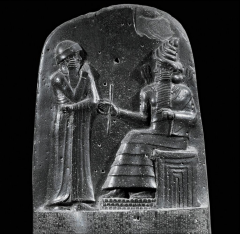
|
Babylonian *Hammurabi and Shamash, stele of Hammurabi, from Susa. Iran, ca. 1780 BCE. Basalt, stele 7' 4" high. Louvre, Paris. -The stele that records Hammurabi's remarkably early comprehensive law code. A relief depicting Hammurabi in the presence of the flame- shouldered sun god, Shamash. The king raises his hand in respect . The god extends to Hammurabi the rod and ring that symbolize authority. The sculptor depicted Shamash in combined convention of front and side views, and explores the notion of foreshortening - a device for suggesting depth by representing a figure or object at an angle. Shamash's beard is a series of diagonal rather than horizontal lines, suggesting it's succession from the picture plane. The bold departure of the register format (normal representational modes) testify the creativity of ancient Near Eastern artists. |
|
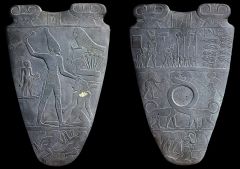
|
Egyptian Predynastic Period *Palette of King Narmer (left, back; right, front), from Hierakonpolis, Egypt, Predynastic. Slate, ca. 3000-2920 BCE. Slate, 2' 1' high. Egyptian Museum, Cairo. -These historical reliefs commemorate the unification of Upper and Lower Egypt. Narmer, the largest figure, effortlessly defeats a foe on one side, and on the other surveys the beheaded enemy. The palette, containing some of the earliest hieroglyphic inscriptions ever found, is commonly used in the Predynastic period to prepare eye makeup, in which Egyptians used to protect their eyes from glare and irritation from the sun. At the top of each palette are the two heads of the goddess Hather, divine mother of the pharaoh, who nourishes him with her milk and here takes the form of a cow with a woman's face. Between the Hather heads is a hieroglyph with Narmer's name representing the royal palace. Below that the story of the unification of Egypt unfolds in registers. On the back of the palette the king, wearing the Upper Egypt crown (high bowling pin shaped) slays an enemy. The falcon, who is Horus the special protector of the pharaohs, takes a captive man-headed hieroglyph with a papyrus plant growing that stands for the land of Lower Egypt. Below the king are two fallen enemies. The bull symbolizes the king's superhuman strength. Historical narrative was not the artists goal in this work but the characterization of the king as supreme. |
|

|
Late Minoan (c. 1450-1375 BCE) *Bull Leaping, from the palace complex, Knossos, Crete. ca. 1550–1450 BCE (restored), 62.3 cm -This famous fresco depicts the Minoan ceremony of bull-leaping. The Minoan Artist painted the young women (with fair skin) and the young male (with dark skin), also seen in ancient Near Eastern and Egyptian Art in sex distinguishing. The young man is in midair, having, it seems, grasped the bulls horns and vaulted over its back in a difficult acrobatic maneuver. The painter suggested the powerful charge of the bull by elongating its shape and using sweeping lines to form a funnel of energy. The human figures also have stylized shapes with typically Minoan pinched waists. |
|
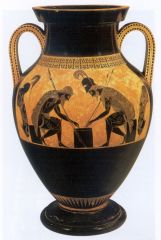
|
Archaic (c. 600 480): meaning “old,” only because it is the period right before the “Classical,” the major period in the Greek culture with its signature art styles. *Exekias. Achilles and Ajax Playing Dice. Black-figured amphora, Whole vessel Height 2’ (61cm) ca. 540–530 BCE -Such signatures, common on Greek vases, reveal pride and sense of self-identity as an "artist" serving as "brand names" because the ceramic workshops of Athens and Corinth exported their vases widely. Exekias, unlike his Geometric predecessors, used figures of monumental stature and placed them in a single large framed panel. At the left is Achilles fully armed. He plays a dice game with his comrade Ajax, who has his helmet removed, but both men hold their weapons nearby ready for action The gravity and tension that characterize this composition are rare in Archaic Art. Exekias used spears to lead viewers eyes to Ajax and Achilles focus viewpoint, the rolling dice, the intricate engravings on their cloaks are masterful. |
|

|
Augustan *the Villa of Publius Fannius Synistor at Boscoreale, near Pompeii. Mid-1st century BCE, ca. 50-40 BCE, Fresco, 8'9" high. -In later second style designs , painters created a three-dimensional setting that also extends beyond the wall, the Villa of Publius being an example. The painter opened up the walls around the room with vistas of Italian towns, marble temples, and colonnaded courtyards. Painted doors and gates invite the viewer to walk through the wall. Knowledge of single point linear perspective explains the painter's success in suggesting depth. Ancient writers state that Greek painters of the fifth century BCE first used linear perspective for the design of Athenian stage sets. In Boscoreale cubiculum, the painter most successfully used linear perspective to the far corners, where a low gate leads to a peristyle framing a round temple. |
|
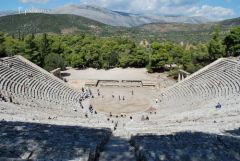
|
Early Classical or Transitional Period *Theater, Epidauros. Early 3rd to 2nd centuries BCE, concrete -The formal Greek theatre was a place where ancient rites, songs, and dances were performed. This circular piece of earth with a hard and level surface later became the orchestra ("dancing place") of the theatre. The spectators sat on a slope overlooking the orchestra-the theatron ("place for seeing").When the theatre took shape builders always situated the auditorium on a hillside. The Epidaurus theater was famous for the harmony of its proportion, although spectators in some seats had obstructed views of the skene (scene building) and all had unobstructed views of the orchestra. |
|
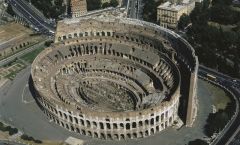
|
Imperial *Colosseum, Rome. 72–80 CE, concrete -The decision to build the colosseum was very shrewd politically. The site chosen was on the property Nero had confiscated from the Roman people after a great fire in 64 CE in order to build a private villa for himself. By constructing the new amphitheater there, Vespasian reclaimed the land for the public and provided Romans with the largest arena for gladiatorial combats and other lavish spectacles . The colosseum holds more than 50,000 spectators. The huge statue which stood at the entrance to his villa, portrayed the emperor as the sun god. Like the much earlier Pompeian amphitheater, could not have been built without concrete. Barrel vaulted corridors holds up the enormous oval seating area. Also exposed are the arena substructures, which housed waiting rooms for the gladiators, animal cages, and machinery for the raising and lowering stage sets as well as animals and humans. Within the exterior travertine, the façade is divided into four bands with large arched openings. Ornamental Greek orders frame the arches from the ground up with Doric, Ionic and Corinthian. |
|
|
Statues of worshipers from Abu Temple |
Sumerian Tell Asmar Limestone, alabaster, and gypsum, Iraq. ca. 2700-2500 BCE |
|
|
Kroisos, from Anavysos |
Archaic Greece, ca. 530 BCE. Marble, 6' 4"high. |
|
|
Augustus of Primaporta |
Early Classical or Transitional Period Italy. Early 1st century CE. Height 6’ 8”, marble,. |
|
|
Hammurabi and Shamash, stele of Hammurabi |
Babylonian stele of Hammurabi, from Susa. Iran, ca. 1780 BCE. Basalt, stele 7' 4" high. Louvre, Paris. |
|
|
Palette of King Narmer |
Egyptian Predynastic Period from Hierakonpolis, Egypt, Predynastic. Slate, ca. 3000-2920 BCE. Slate, 2' 1' high. |
|
|
Bull Leaping |
Late Minoan, from the palace complex, Knossos, Crete. ca. 1550–1450 BCE , 62.3 cm
|
|
|
Exekias. Achilles and Ajax Playing Dice |
Archaic, Black-figured amphora, Whole vessel Height 2’ (61cm) ca. 540–530 BCE
|
|
|
The Villa of Publius Fannius Synistor at Boscoreale |
Augustan near Pompeii. Mid-1st century BCE, ca. 50-40 BCE, Fresco, 8'9" high. |
|
|
Theater, Epidauros |
Early Classical or Transitional Period Early 3rd to 2nd centuries BCE
|
|
|
Colosseum |
Imperial Rome. 72–80 CE, |

